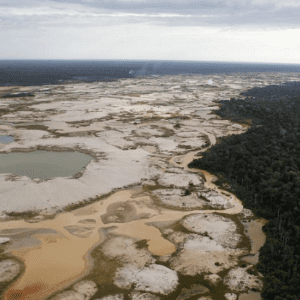The density and biomass of mesozooplankton and ichthyoplankton in the Negro and the Amazon Rivers during the rainy season: the ecological importance of the confluence boundary
Peer JNakajima R, Rimachi EV, Santos-Silva EN, Calixto LSF, Leite RG, Khen A, Yamane T, Mazeroll AI, Inuma JC, Utumi EYK, Tanaka A.
2017
The boundary zone between two different hydrological regimes is often a biologically enriched environment with distinct planktonic communities. In the center of the Amazon River basin, muddy white water of the Amazon River meets with black water of the Negro River, creating a conspicuous visible boundary spanning over 10 km along the Amazon River. Here, we tested the hypothesis that the confluence boundary between the white and black water rivers concentrates prey and is used as a feeding habitat for consumers by investigating the density, biomass and distribution of mesozooplankton and ichthyoplankton communities across the two rivers during the rainy season. Our results show that mean mesozooplankton density (2,730 inds. m-3) and biomass (4.8 mg m-3) were higher in the black-water river compared to the white-water river (959 inds. m-3; 2.4 mg m-3); however an exceptionally high mesozooplankton density was not observed in the confluence boundary. Nonetheless we found the highest density of ichthyoplankton in the confluence boundary (9.7 inds. m-3), being up to 9-fold higher than in adjacent rivers. The confluence between white and black waters is sandwiched by both environments with low (white water) and high (black water) zooplankton concentrations and by both environments with low (white water) and high (black water) predation pressures for fish larvae, and may function as a boundary layer that offers benefits of both high prey concentrations and low predation risk. This forms a plausible explanation for the high density of ichthyoplankton in the confluence zone of black and white water rivers.
View more
Female Leadership During Migration and the Potential for Sex-Specific Benefits of Mass Spawning in the Brown Surgeonfish (Acanthurus nigrofuscus)
Environmental Biology of FishesMoshe Kiflawi, Anthony I. Mazeroll
2006
Spawning aggregations in coral-reef fishes have been hypothesized to confer any one of several mutually non-exclusive benefits, largely expected to serve the interests of both sexes simultaneously. Here we provide indication that in the brown surgeonfish, Acanthurus nigrofuscus, spawning aggregations may confer a sex-specific benefit. Following tagged individuals en-route to their daily spawning-aggregation site we found that while migrating groups (≤20 fish) consist of both males and females, females tend to occupy the lead position more often than expected by chance. In addition, we found evidence that female A. nigrofuscus divide their daily egg-stock among several spawning bouts within the aggregations. We propose that female leadership en-route to spawning aggregations, together with the potential benefits of multiple female mating, are consistent with a sex-specific benefit to spawning aggregations.
View more
Daily migrations of a coral reef fish in the Red Sea (Gulf of Aqaba, Israel): Initiation and orientation
CopeiaAnthony Inder Mazeroll, W. Linn Montgomery
1998
Brown surgeonfish (Acanthurus nigrofuscus) in the Red Sea near Eilat, Israel, undergo daily migrations of up to 1.5 km to feeding sites throughout the year and to spawning sites during June through August. We investigated, by observation and experimentation, the cues that initiate migrations to spawning and feeding sites. We also examined the possible roles that odors, the sun, electromagnetic detection, and landmarks have in determining the routes fish take to the various sites...
View more
Does mass spawning enhance fertilization in coral reef fish? A case study of the brown surgeonfish
Marine EcologyMoshe Kiflawi, Anthony I. Mazeroll, and Denis Goulet
1998
'Mass spawning' refers to the simultaneous and apparently synchronous spawning of the majority of a mating aggregation. In this study we compare the fertilization rates (FRs) attained by the brown surgeonfish Acanthurus nigrofuscus, an externally fertilizing coral reef fish, when spawning in small groups (4 to 15 individuals) and as part of a mass spawning aggregation (500 to 2000 individuals). Our objective is to test an hypothesized fertilization advantage to mass spawning and, thereby, to mating aggregations...
View more
Structure and Organization of Local Migrations in Brown Surgeonfish (Acanthurus nigrofuscus)
Ethology: International Journal of Behavioural BiologyAnthony Inder Mazeroll, W. Linn Montgomery
1995
In the northern Red Sea (Gulf of Aqaba, Israel), brown surgeonfish (Acanthuridae: Acanthurus nigrofuscus) migrate, in small groups, up to 1.5 km each day from nocturnal shelters to feeding sites in the morning, and from feeding sites back to shelters in the late afternoon. During the summer spawning season, groups of these fish undertake an additional migration of up to 1 km to and from sites of mass-spawning aggregations. The total number of fish migrating to the Laromme feeding site was relatively stable (X̄ = 1018) throughout the study period (1988–1990).
View more




